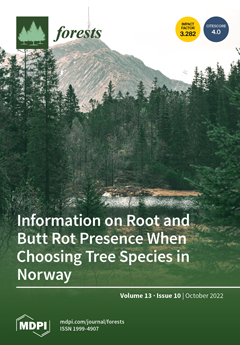As a pivotal wetland tree,
Taxodium hybrid Zhongshanshan has been widely planted in the region of Yangtze River for multipurpose of ecological restoration, field shelter, landscape aesthetics as well as carbon sequestration. However, the carbon allocation patterns across distinct stages of stand development
[...] Read more.
As a pivotal wetland tree,
Taxodium hybrid Zhongshanshan has been widely planted in the region of Yangtze River for multipurpose of ecological restoration, field shelter, landscape aesthetics as well as carbon sequestration. However, the carbon allocation patterns across distinct stages of stand development of
T. Zhongshanshan are poorly documented. Using a sample of 30 trees which were destructively harvested, this study compared 3 models for assessing aboveground biomass. Furthermore, a linear seemingly unrelated regression (SUR) approach was introduced to fit the system of the best selected model that ensured the additivity property. On this basis, biomass and carbon storage of
T. Zhongshanshan stands in the Yangtze River Basin (YRB) were fairly estimated. Specifically, the study developed height-diameter at breast (
H-
DBH) function. The results showed that the selected 3-parameter polynomial model performed better, and the SUR approach provided more accurate estimates of leaf and stem fractions. The total tree biomass was 53.43, 84.87, 140.67, 192.71 and 156.65 t ha
−1 in the 9-, 11-, 13-, 15-, and 22-year-old
T. Zhongshanshan stands, and contributed averagely 94.40% of the ecosystem biomass accumulation. The current
T. Zhongshanshan stands in the YRB area can store 124.76 to 217.64 t ha
−1 carbon, of which total tree ranges from 25.32 to 90.89 t ha
−1, with 55.19% to 77.66% storing in the soil. The
T. Zhongshanshan had continuous potential for carbon storage during its growth, particularly in the incipient stages. The findings of this research are firsthand information for forest managers for the sustainable management of
T. Zhongshanshan in the YRB and similar subtropical areas.
Full article





